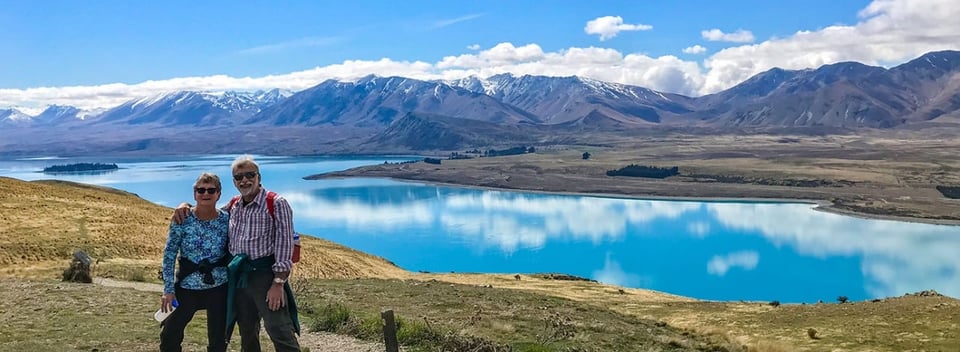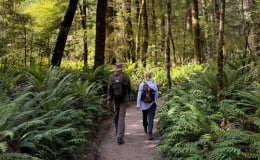
What’s the Best Time for Hiking in New Zealand?

In this article:
1. The best time for hiking in New Zealand 2. Kiwi hiking lingo 3. Hiking New Zealand in Spring 4. Hiking New Zealand in Summer 5. Hiking New Zealand in Autumn 6. Hiking New Zealand in Winter 7. So, what is the best time for hiking in New Zealand?New Zealand is known as a hiker’s paradise with a network of amazing tracks and trails weaving their way up and down the country. With thousands of kilometres of track spread across the North and South Islands, there’s a walk or hike to suit everyone no matter their age or ability.
If you’re planning a trip to New Zealand and would like to do some hiking or walking while you’re here, you’re already off to a good start. With 20 years of experience running the very best New Zealand hiking tours we're experts on the subject and love to share our favourite places with our guests from around the world. Exploring New Zealand on foot is one of the best ways to make the most of your time here as it gives you unparalleled access to the most beautiful parts of our country. New Zealand hiking is also something of a national pastime for Kiwis, so it’s a great chance to get out there and meet the friendly locals as you soak up the views together on some amazing New Zealand hikes.
The best time for hiking in New Zealand
Any time during our hiking season which runs from October through to April is a great time to visit New Zealand. Our climate is lovely and temperate, with the highest temperatures in these months only reaching around the mid 20s C or high 70s F - the perfect temperature for getting outside and exploring.
If we had to choose, March and April (our early Autumn) and November and December (our late Spring) are some of our favourite months for exploring. Autumn is characterised by bright blue skies and a lack of wind and rain. The leaves are starting to turn golden, long sunny days linger on, and quiet trails make for perfect hiking. Spring is one of the most colourful and vibrant times of the year. The famous lupins and Mt Cook lilys are in full bloom, the lambs are frolicking in the fields, and we get the most spectacular sunrises and sunsets. We still have a dusting of snow on the very tops of the mountains making the perfect backdrop for your holiday photos. The days are getting longer and the temperate weather conditions are perfect for getting out and exploring. If you're a lover of wildlife, this is the best time of year to see penguins and fur seal pups.
Kiwi hiking lingo
To set the scene and avoid any potential misunderstandings out on the trail, we wanted to start by compiling a shortlist of a few common Kiwi words and phrases that you’ll probably hear while you’re researching your trip, or indeed while you’re out and about on some of those New Zealand hikes. It’s by no means exhaustive, but hopefully, it should clear up a few things and avoid confusion!
Tramping:
The uniquely Kiwi way to say you’re going hiking. A ‘tramp’ is a hike, so to say, ‘I’m going tramping’ means ‘I’m going hiking’. Also, a ‘tramper’ is a hiker. You’re going to hear this word A LOT.
Great Walks:
New Zealand’s ‘Great Walks’ consist of ten premier walking trails located up and down the country. Well maintained and extremely popular, the tracks traverse some of our most stunning and iconic scenery. Rightfully famous, they often require booking months in advance, especially during the summer months.
DOC:
DOC stands for Department of Conservation (or ‘Te Papa Atawhai’ in the Māori Te Reo language). It’s a public service department in charge of conserving New Zealand’s natural and historical heritage.
DOC Hut:
The Department of Conservation manages a network of over 950 huts of all shapes and sizes throughout the country. Strategically positioned along the various hiking trails, they provide a warm and welcome place for hikers to rest, shelter from the weather or stay the night during their walk. Basic facilities typically include wood fire, bunk beds with foam mattresses and stored water supply.
Bush:
Native New Zealand forest. You might hear the phrase ‘I’m going bush for the weekend’, which means getting away from it all and spending some time in the great New Zealand outdoors.
Backcountry:
This refers to New Zealand’s largely uninhabited areas of breath-taking natural beauty. A backcountry hike will allow you to head out into the rugged wilderness and soak up New Zealand in all its glory.
Now that you’re suitably clued up on some Kiwi hiking lingo, let’s discover a little more about New Zealand’s seasons and the best time of year to head out for some bush or backcountry tramping!

Can't decide when to visit New Zealand? No matter the time of year, Key Summit puts on a show.
Seasonal hiking in New Zealand
New Zealand’s climate is very favourable to hiking and for the most part, there are no bad times to visit New Zealand, only better times! As a small landmass surrounded by ocean, we enjoy a temperate maritime climate, which means we rarely experience extreme weather conditions either way.
Our climate varies from subtropical in the far north, to temperate in the far south. Most of our National Parks and New Zealand hiking trails are open to walkers year-round, however, the time of year you visit will make a difference to your experience. Let’s investigate the seasons a little further.
Hiking New Zealand in Spring
September, October and November – the start of our walking and hiking season. Bright, sunny days, blossom on the trees, wildflowers blooming, waterfalls at their peak flow and walking guides raring to go, fresh from their winter hibernation.

Gorgeous native Kowhai flowers, some of the many blooms that appear during spring in New Zealand.
Spring is one of the best times for hiking in New Zealand and really, what’s not to love? Comfortable temperatures, new growth, baby animals and plenty of sunshine.
New Zealand’s spring months are September, October and November, although it can sometimes stick around until December too. Weather-wise, spring temperatures are mild and perfect for hiking as it never gets too hot or too cold.
Pros of spring hiking
Longer daylight hours
As is the case in many parts of the world, our clocks ‘spring’ forward at the start of spring each year. Come the last Sunday in September, we’re all eagerly anticipating the clock change; whilst it means we get an hour less in bed in the morning, it does give us an extra hour of daylight to enjoy at the end of the day. It’s wonderful basking in the evening sun after the darker nights of winter, plus it opens the door to a myriad of after-work options, from hiking and biking to enjoying a tasty meal and a glass of wine outside in the sun.
Varying slightly depending on whereabouts you are in the country, the sun rises at around 6am and sets at about 8.30pm, giving you on average 14.5 hours of daylight to make the most of. As spring progresses, the days get longer and longer, which is ideal for hikers as it means there’s plenty of daylight to clock up those extra kilometres on the trails. As the evenings draw out, you’ll find you don’t need to rush to finish the hike before the sun sets. And there’s certainly something to be said for taking your time and appreciating the beautiful spring scenery on offer.
The spring scenery
Spring is perhaps best represented through the changes it brings to our landscape, with new growth flourishing in the form of daffodils, cherry blossoms, wildflowers and native plants like the bright yellow kowhai and harakeke (flax). Our countryside is alive with fresh greenery and young plant life establishing itself after the winter months.
During your travels, you’re more than likely to spot vast swathes of wild lupins growing on the side of the track or on the valley floor. Purple, pink and yellow in colour, these pretty wildflowers are quite spectacular en masse and you’ll want to keep your camera handy to capture the views. One of the best places to enjoy the wild lupins is Lake Tekapo on the South Island, an area we visit on all of our New Zealand Trails South Island trips. Nestled at the foot of the towering Southern Alps, the turquoise waters of the lake contrast beautifully with the colourful display of the lupins.

A field of joyful pink and purple Lupins near Lake Tekapo can make spring the best time to hike in New Zealand.
Another bonus of hiking in New Zealand during the spring months is the waterfalls. Many of our hiking tracks and trails meander past impressive falls that are at their finest during the spring months due to a little additional rainfall, as well as the snowmelt after winter. Milford Sound is particularly majestic at this time of year, with its many hundreds of waterfalls cascading down the sheer granite faces of the fiord. We’ll be sure to show you a few of our favourite waterfalls during your time here.
Farm animals and other wildlife
There’s nothing that shouts ‘Spring’ quite like lambs, and you’ll quickly discover that they’re plentiful here in New Zealand. They’re a delight to watch as they struggle to contain their joy, charging around the green fields like lunatics, before collapsing in the sun exhausted from the sheer fun of it all! If you’re travelling about on our country roads, you’ll also see lots of cute calves soaking up the sunshine in the paddocks with their buddies.
Aside from lambs and calves, spring also sees a burst in activity from our other resident wildlife, with the New Zealand fur seals pupping, Fiordland crested penguins breeding and native birds such as the tui and bellbird singing in the treetops. If you’re a wildlife fan, then spring is hands down the time to be out exploring and observing our feathered friends in their natural habitats. Lake Mapourika on the West Coast of the South Island is a particularly good spot as it’s home to over 70 different species of bird. You’re sure to catch a glimpse or two during a relaxed kayak on the tranquil waterways of the lagoon.
Our favourite spring hikes
Key Summit on the Routeburn Track | 3.4km (2.1 miles) one way

The view from Key Summit is absolutely worth the walk!
This half-day hike is one of our absolute favourites and spring is one of the best times to be out on the track. Located in beautiful Fiordland National Park, the Key Summit track is part of the famous Routeburn Track (one of our Great Walks) and enjoys incredible views across the Humboldt and Darran Mountain ranges.
Starting just off the Milford Road at The Divide, you’ll walk about an hour on the Routeburn Track to get to the start of the climb up to Key Summit. It’s about a 20-minute climb to the top from where you’ll enjoy panoramic views of the National Park spilling out around you. During the spring months, there’s usually still a wee bit of snow on the surrounding peaks which means the views are even more dramatic than usual, especially when reflected in the mountain tarns.
You’ll see a variety of native vegetation, which changes and evolves as you gain altitude. Birdlife is prolific, particularly during spring, and you’re likely to spot New Zealand wood pigeons, tomtits, robins and bellbirds darting between the beech trees as you hike the trail.
We hike Key Summit on our Masterpiece and Kiwi Classic trips.
Hooker Valley Track, Mount Cook National Park | 10km (6.2 miles) return
Keep an eye out for blossoming Mt Cook Lily's on the Hooker Valley Track
This is one of the South Island’s most popular day hikes and enjoys remarkable views of our highest peak, Mount Cook/Aoraki. We follow the trail that winds up the Hooker Valley past alpine streams and ancient glaciers, crossing several swing bridges to get to our destination - Hooker Lake, complete with icebergs. The Hooker Valley during spring is one of the best places to see the iconic Mount Cook lily in bloom, a hardy flowering plant that’s adapted well to its seemingly inhospitable surrounds.
You’ll have a chance to hike this track on our Grand Explorer trip, as well as our other South Island journeys.
Hiking New Zealand in Summer
December, January, February – generally warm, settled weather and lots of sunshine. Long, light evenings mean it’s a fantastic time to make the most of the outdoors.
Summer is the peak season for visitors to New Zealand and if you’ve read up until now, you’ll understand why. In 2017, a record-breaking 3.7 million international visitors descended on our shores, a sizeable chunk of whom came during the summer months. For a hiker keen to experience our Great Walks, it’s the most popular time of year which means places on guided hikes and spaces in DOC huts are at a premium.
Accommodation in popular holiday destinations can also be scarce, so it’s worth booking your trip, accommodation and activities well in advance if you intend to travel over the summer months.
Luckily if you’re taking a New Zealand Trails trip then you don’t need to worry about any of that as we’ll take care of all the nitty-gritty details! We also pack our trips with lots of off-the-beaten-track locations and hikes that will fulfil your desire for tranquillity in a stunning New Zealand setting.
It’s worth noting that while summer is our busiest season, New Zealand never really gets as busy as, say, the European Alps. With a small population of just over 4.5 million and plenty of wide-open spaces, there’s enough room for everyone without getting under each other’s feet. There are plenty of secluded beaches, quiet coves, peaceful walking trails and picturesque mountain lakes to enjoy, and despite the additional numbers, often you can still get those views all to yourself!

A sunny summer's day at Cathedral Cove.
Summer is an idyllic time of year here in New Zealand. Long, light days stretch out before you, while the warm sun beams down on relaxed and festive holiday-makers up and down the country. Kicking off in December and lasting through until February, and often on into March as well, summer is vacation season for most Kiwis, with school holidays and business closures on the cards for many.
January and February are typically the warmest months of the year, with temperatures hovering between 23 and 28°C (73 – 82°F) up and down the country. Over the summer months, we enjoy long days, with the sun rising at around 5.30am, and not setting until around 10pm at the height of summer. That’s an awesome 16.5 hours of sunlight to do with what you will – perfect for both relaxed hikers or those intent on an epic mission. Weather-wise, you may get the odd shower during your travels, but for the most part, you can anticipate blue skies and glorious sunshine!
Pros of summer hiking
Friendly locals
The seemingly endless sun-drenched days spread an infectious summer holiday vibe across the whole country and you’ll encounter many Kiwis out hiking on the trails, making the most of their time off work or school. Many trades and businesses shut down for at least two weeks over the Christmas and New Year period, so it’s a chance for lots of Kiwis to get out and enjoy their own backyard.
As well as hiking, popular summer pastimes include BBQs, swimming, biking, cricket, camping and snoozing in the sun with a good book!

A late summer's day on the Rocky Mountain trail.
Out on the trails, you’ll meet a variety of locals enjoying their summer holidays and mixing it up with day hikes and multi-day tramps. Well-equipped and friendly, they’re often happy to share a handful of their scroggin and offer a pointer or two for the track ahead.
Our favourite summer hikes
Abel Tasman Track

The golden sand beaches of Abel Tasman National Park in summer
Abel Tasman National Park is New Zealand’s smallest national park and one of our most iconic. With its golden sand beaches, crystal clear water and lush native forest, it’s a hiker's paradise.
The trail is accessible by boat, kayak or on foot. You can stay at one of the many beachfront lodges and enjoy a crisp glass of wine or beer after a stunning day of walking
You can opt to hike the full length of the track, or just enjoy a day walk on the Abel Tasman. We reckon we’ve nailed the ultimate way to experience the Abel Tasman on our Grand Explorer trip. We take a water taxi to the luxurious Awaroa Lodge where we'll base ourselves for two nights of walking, kayaking and relaxing by the coast.
Hiking New Zealand in Autumn
March, April, May – dazzling autumn colours make for a photographer’s dream! Long, sunny days linger on and quieter trails with cooler temperatures make this an ideal time for walking.

Autumn hiking in Siberia Valley is some of the best there is.
Autumn is one of our most colourful seasons and enjoys mild temperatures and settled weather, with plenty of clear sunny days. As a result, it’s a popular time for travellers and hikers, although not quite to the same degree as the summer months. Autumn in New Zealand runs from March through until May, with the first few weeks of the season often still feeling more like summer. March is the perfect time of year for those who want to make the most of the warmer temperatures and longer daylight hours of summer while avoiding the crowds and scoring a good deal on flights.
As far as temperature goes, March is usually only a few degrees cooler than the summer months, with average daytime temperatures ranging between 18 and 23°C (64 - 73°C). It’s these comfortably warm conditions that make March such an excellent time of year for hiking.
As far as the temperature goes, conditions are still mild during the month of April, with the thermometer usually hovering somewhere between 16 and 20°C during the day (61-68°F).
May is when you might really start to notice things cooling down and you might even get the odd frost on the ground in the South Island. You’ll need to bring a warm jumper and a pair of woolly socks to keep you cosy if you’re heading down our way in May. Daytime temperatures on the South Island can quite easily drop to below 10°C (50°F), while up on the North Island, it’s usually a degree or two warmer in most places.
Days are starting to get markedly shorter by the end of May, with the sun not rising until after 8am and setting by 5.15pm. If you’re after a true autumn vacation (as opposed to a winter sampler in May) and want to make the most of our hiking tracks and trails, then March and April are the months to aim for.
Pros of autumn hiking
Settled weather
March and April typically enjoy some of the most settled weather conditions of the year, with long, fine spells common. These months are characterised by warm sunny days, bright blue skies and a lack of wind and rain. It’s an ideal time to be out and about hiking and you’ll enjoy some longer periods of dependably pleasant weather. Plus, as it’s a few degrees cooler than summer, temperatures are perfect for stretching your legs without breaking a sweat!
Fewer people around
After the crowds (a term I use lightly, as New Zealand is never really teeming) of summer, the autumn months are quiet in comparison. Children are back in school and the locals are working hard, already looking forward to their next opportunity to get back out into the wilderness – hang on guys, the next long weekend is just around the corner! Most holiday-makers want to visit when it’s hottest so, despite March and April still enjoying sunny and warm weather, the popular spots are generally significantly quieter.
All of this means that it’s the ideal time of year to get out on our tracks and trails, especially the more famous ones which are often quite busy over the summer months. It’s worth noting that some of our Great Walks have a specific hiking season, usually October through April, so if an autumn trip is on the cards for you, then be sure to plan for either March or April so that you don’t miss out.

Look forward to less activity and more peace and quiet on the tracks.
Autumn colours and local produce
New Zealand is known for its lush green rolling hills and abundance of trees, but as autumn rolls around the foliage starts to change colour, covering our hillsides in a fiery red and yellow blanket. It’s an incredibly beautiful time to get out hiking on our colourful tracks and trails. The South Island is exceptionally glorious at this time of year, with places such as Wanaka and Queenstown ablaze with autumn colour.
The quaint gold-mining settlement of Arrowtown, just outside of Queenstown, is one of our favourite places to visit in autumn – the surrounding leafy hillsides turn bright yellow, orange and red. The vivid colours set against the clear blue autumn skies create stunning photographic opportunities, as well as very enjoyable hiking backdrops. Arrowtown celebrates all the beauty of autumn with a five day festival in April, showcasing a variety of local talents, market crafts, food and wine.
Speaking of wine, the autumn months also herald the start of harvest time for many vineyards. Before the first frost hits, you’ll spot an abundance of plump purple and white grapes patiently hanging from their vines, awaiting the busy hand of the pickers and their higher purpose of filling your glass! If you’re interested in New Zealand wine, then check out this guide to our 12 different wine regions. Fresh local produce is abundant at this time of year, with farmers markets in full swing. So, if you’re a foodie as well as a hiker, then you’ll enjoy autumn immensely.
Our favourite hikes in Autumn
Milford Track, Fiordland National Park | 53.5km (33.2 miles) one way

The views on the Milford Track are nothing short of amazing, and one of the best New Zealand hikes.
Perhaps our most famous hike, the Milford Track draws visitors from around the globe to experience the majestic Fiordland National Park and the impressive peaks of Milford Sound itself. Follow in the footsteps of the early pioneers who journeyed from the head of Lake Te Anau through to Milford, via valleys and over mountain passes, through thick forest and lush native plant life, marvelling at the cascading waterfalls and enjoying the company of chattering birds flittering in the treetops above them.
You can get exclusive access to the Milford Track on our New Zealand Great Walk Adventure South and Grand Explorer trips.
Tongariro Crossing, Tongariro National Park | 19.4km (12miles) one way

Stunning blue skies above the Tongariro Crossing remind you that you're not, in fact, on Mars!
Tongariro is New Zealand’s first National Park and boasts dual World Heritage status, as well as being home to an otherworldly geothermal landscape! This stunning hike traverses a strange natural landscape made up of volcanic tundra, turquoise coloured lakes and a flat plateau that stretches out below you. It’s a good climb to the top where you’ll be rewarded with spectacular views on a clear day.
The best time to hike in New Zealand, particularly the Tongariro Crossing, is from October to the end of April, with the summer months the most popular. Things start to quieten down in March and April, so that’s our favourite time of year to hike the Crossing.
You can hike the Tongariro Crossing with us on our Great Walk Adventure - North tour where we’ll make an early start to get the most from our day’s hike. We’ll take care of everything, from transport and checking the weather, to snacks and camaraderie, all you need to do is lace up your boots and enjoy the views!
Hiking New Zealand in Winter
June, July, August – New Zealand Trails doesn’t run any trips during winter. However, it’s a great time for skiing and the snow-capped mountains are spectacular.

Instead of walking in winter, Kiwis prefer to engage in snow activities! Keep that in mind if you're wondering when to visit New Zealand.
Winter – brrrrrrrrrrrrr! For some, the mere mention of the word sends them scurrying into hibernation on the couch and while we’ve got nothing against relaxation here at Trails, we know that winter in New Zealand still has lots to offer travellers and well-equipped, experienced hikers. The New Zealand winter season lasts from June through until August and sees the most consistently cold weather up and down the country, although probably nothing like what many Americans and Canadians are used to.
In the North Island daytime temperatures usually settle between 10-16°C (50 - 61°F) with the odd frost inland and colder overnight temperatures. The far north of the island is known as the ‘Winterless North’ and temperatures never really drop much below 15 or 16°C, even in mid-winter.
In contrast, the South Island experiences more winter extremes with regular frosts and daytime temperatures struggling to get much above 10°C (50°F). Around the alpine regions, there’s often snow to low levels, as well as regular flurries on the mountain tops. You’ll need to pack a warm jacket, sturdy boots, hat and gloves if you’re going to fully enjoy winter outdoors in the South Island.
Our hiking season at Trails runs from October to April and we don’t offer any trips during the winter months. That’s not to say that you can’t hike, but the winter weather conditions do impose limits on which tracks you can access and how high you can climb. We want our guests to experience the full diversity of landscapes and views New Zealand offers, so we’ve decided to run trips between spring and autumn to ensure that happens. But, if you’re planning a winter trip, we still have a few ideas and tips for you, so read on.
New Zealand Trails’ tips for winter hiking
✔ Be prepared
Many of New Zealand’s most famous walks simply can’t be accessed over the winter months due to snowfall and dangerous conditions. If you are going to head out on an unguided hike into backcountry areas over winter, ensure that you chat with DOC and stay updated on track and weather conditions. Outside of the Great Walks season, facilities, including bridges, are greatly reduced and flood and avalanche risks exist, so you need to have plenty of experience and be prepared for these conditions.
We can’t stress enough how changeable conditions can be over the winter months in these isolated areas. Cell coverage is limited, and you won’t find many other people out on the track, so if in any doubt, stick to low-level hikes in more populated areas.
✔ Stay warm
The days are shorter and colder, so you’ll want to dress warmly even if you’re just out for a short hike. Always bring a few additional layers in your day pack just in case. Merino wool is a great investment and will keep you warm, snug and dry underneath your outer layers. Choose boots or shoes with a good grippy sole for ice and snow days and remember your hat and gloves. If you’ve got the proper gear, winter in New Zealand can be exhilarating and refreshing, if not, you might just wind up shivering in the local coffee shop the whole time!

Yes, it certainly snows like this from time to time in New Zealand!
So, what is the best time for hiking in New Zealand?
We hope this summary of the seasons in New Zealand has helped you decide when to visit New Zealand. As anyone who has visited will know, the weather here doesn’t always follow the rules, but no matter what time of year you visit, you’ll have an incredible time in the land of the long white cloud! If we had to choose, March and April (our early Autumn) and November and December (our late Spring) are some of our favourite months for exploring. Autumn is characterised by bright blue skies and a lack of wind and rain. The leaves are starting to turn golden, long sunny days linger on, and quiet trails make for perfect hiking. Spring is one of the most colourful and vibrant times of the year. The famous lupins and Mt Cook lilys are in full bloom, the lambs are frolicking in the fields, and we get the most spectacular sunrises and sunsets. We still have a dusting of snow on the very tops of the mountains making the perfect backdrop for your holiday photos. The days are getting longer and the temperate weather conditions are perfect for getting out and exploring. If you're a lover of wildlife, this is the best time of year to see penguins and fur seal pups.
The Trails’ season kicks off every spring in October and our fully-guided, multi-day, New Zealand hiking tours set off around this beautiful country again. Whether you are looking for the comfort and restaurant dining offered on our Grand Explorer, or the Masterpiece's mix of activity and experiences, the more challenging Kiwi Classic, the Pure South for those who want an awesome adventure jam-packed into eight days, The New Zealand Great Walk Adventure to experience four Great Walks in five days, or a cultural taste of the North Island offered by the Sweet North – we're sure to have something just right for you.
If you're still unsure you can check out our which trip is right for me page or, of course, you can just ask us any time!
If you'd like to find out more about the hiking trips you can do with us at New Zealand Trails, request your free brochure now.
Other articles you may like:
- Luxury Hiking in New Zealand
- Hiking Preparation - 5 Tips to Get Ready
- The Great Walks of New Zealand
- The Best New Zealand Small Group Tours
- Get your free New Zealand Trails guided tour brochure








